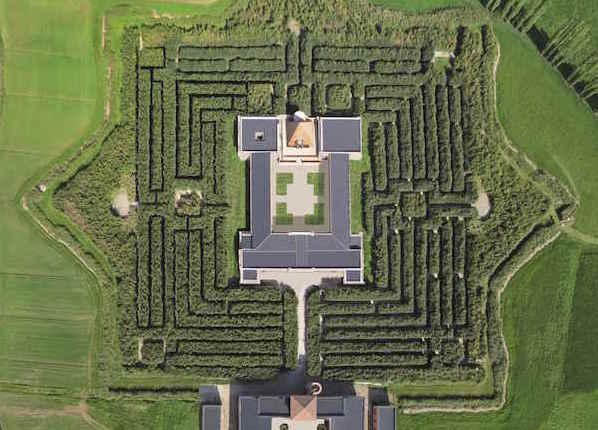The Masone Labyrinth (Labirinto della Masone) of Franco Maria Ricci in Fontanellato, Italy, is 7 hectares (17 acres), making it the largest labyrinth in the world. Will you ever escape its tunnels of green gloom?


The star-shaped Masone Maze is based on a Roman labyrinth style, with right angles divided into quarters and with a single path, however Ricci has cunningly added some extra little traps to turn it into a true maze, like blind alleys and additional junctions along the 3 kilometres (3280 yards) of internal paths.

The maze is grown from bamboo, which Ricci fell in love with back in 1980s, and there are more than 20 different species planted throughout the park. It’s a perfect plant for a maze, being quick growing to the maximum pruned height of 5 metres (nearly 17 feet), evergreen, pest and disease free and a great absorber of carbon dioxide. Many of the bamboos featuring in the Masone gardens are from the Bambouseraie d’Anduze in France. Ricci says:
“If bamboo (my park has 25 different species) has grown so lush it’s perhaps because it breathes easily, a short way from a river whose name smells of China – the Po.”

There are 120,000 bamboo plants in the maze from a variety of species, including Phyllostachys viridiglaucescens, Phyllostachys pubescens (syn. Phyllostachys edulis), Phyllostachys viridis ‘Sulfurea’, Phyllostachys bissetii, Hibanoubambusa tranquillans ‘Shiroshima’, Pleioblastus viridistriatus and Pleioblastus pumilus.
Franco Maria Ricci is known as an Italian art publisher, of the art and design magazine FMR, and also of high quality collector’s editions of books on art, history and design, featuring his favourite Bodoni typeface. He has also published a book on labyrinth design: Labyrinths: The Art of the Maze. As writer Umberto Eco says in his preface:
“..if the image of the labyrinth has a centuries-old history, this means that for tens of thousands of years human beings have been fascinated by something that somehow spoke to them of the human or cosmic condition. there are endless situations in which it is easy to enter, but hard to exit, and at the first attempt, it seems hard to think of situations where it is difficult to enter but easy to exit.”

The height of the maze and closeness of the paths mean that there is very little sunlight with which to orientate oneself for an easy maze exploration. Many paths are tunnels. Quick exits are rare.

At the centre of the maze is a pyramidal chapel, which reflects the close connection throughout history of mazes and religious faith. The Masone Labyrinth complex also includes cultural spaces, Ricci’s art collection and typography and art library, plus bar and two restaurants.


The Masone Labyrinth is in northern Italy, about 80km south-east of Milan just off the A1 Autostrada: Strada Masone 121, 43012 Fontanellato, Parma. Ph. 0521 827081 email: labirinto@francomariaricci.com
[The Masone Labyrinth complex is open every day 10.30am-7pm, except Tuesdays. Tickets cost € 18 and are valid for one day, giving access to the whole complex, including the extensive art and book collections. All paths are wheelchair friendly. Online ticket bookings at Masone Labyrinth.]
All photos reproduced with the kind permission of Labirinto della Masone


You must be logged in to post a comment.